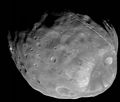فایل:Phobos colour 2008.jpg

سیناق گؤستریشی اؤلچوسو: ۶۳۶ × ۶۰۰ پیکسل. آیری کیفیتلر: ۲۵۵ × ۲۴۰ پیکسل | ۵۰۹ × ۴۸۰ پیکسل | ۸۱۵ × ۷۶۸ پیکسل | ۱٬۰۸۶ × ۱٬۰۲۴ پیکسل | ۲٬۱۷۲ × ۲٬۰۴۸ پیکسل | ۳٬۵۰۰ × ۳٬۳۰۰ پیکسل.
فایلین اصلی (۳٬۵۰۰ × ۳٬۳۰۰ پیکسل, فایل اؤلچوسو: ۲٫۷۲ مگابایت, MIME نوعو: image/jpeg)
فايل گئچمیشی
فايلین اولکی وئرسیياسینی گؤرمک اۆچون گۆن/تاریخ بؤلمهسیندهکی تاریخلری تێقلايین.
| تاریخ/واخت | کیچیک عکس | اؤلچولر | ایشلدن | باخیش | |
|---|---|---|---|---|---|
| ایندیکی | ۲ آوریل ۲۰۱۸، ساعت ۰۳:۱۰ |  | ۳٬۵۰۰ در ۳٬۳۰۰ (۲٫۷۲ مگابایت) | Kaldari | more margin on right side |
| ۱۳ نوْوامبر ۲۰۰۸، ساعت ۰۴:۴۷ |  | ۳٬۳۷۴ در ۳٬۳۰۰ (۲٫۷ مگابایت) | Fir0002 | == Summary == {{Information |Description=Colour image of Phobos, imaged by the Mars Reconnaisance Orbiter in 2008 |Source=NASA |Date=9 April 2008 |Location=http://www.nasa.gov/mission_pages/MRO/multimedia/pia10368.html |Author=NASA/J |
فايل ایشلدمهسی
آشاغیداکی صحیفه بو فایلا باغلانیر
فایلین باشاباش ایشلنیلمهسی
بو فایل آشاغی داکی آیری ویکی لرده ایشلَنیر:
- af.wikipedia.org-ده ایشلنمهسی
- an.wikipedia.org-ده ایشلنمهسی
- ar.wikipedia.org-ده ایشلنمهسی
- المريخ
- فوبوس
- قمرا المريخ
- ويكيبيديا:صور مختارة/الفضاء والكون/نظرة إلى الأعلى
- قائمة أجرام المجموعة الشمسية مرتبة حسب الحجم
- بوابة:علم الفلك/صورة مختارة
- بوابة:المريخ
- بوابة:المريخ/مقالة مختارة/أرشيف
- بوابة:المريخ/مقالة مختارة/2
- قائمة الأقمار الطبيعية
- خط زمني لاكتشاف كواكب المجموعة الشمسية وأقمارها
- ويكيبيديا:ترشيحات الصور المختارة/القمر فوبوس
- ويكيبيديا:صورة اليوم المختارة/أغسطس 2019
- قالب:صورة اليوم المختارة/2019-08-03
- بوابة:علم الفلك/صورة مختارة/73
- معسكر قاعدة المريخ
- ويكيبيديا:صورة اليوم المختارة/يناير 2022
- قالب:صورة اليوم المختارة/2022-01-04
- ary.wikipedia.org-ده ایشلنمهسی
- arz.wikipedia.org-ده ایشلنمهسی
- as.wikipedia.org-ده ایشلنمهسی
- az.wikipedia.org-ده ایشلنمهسی
- be-tarask.wikipedia.org-ده ایشلنمهسی
- be.wikipedia.org-ده ایشلنمهسی
- bg.wikipedia.org-ده ایشلنمهسی
- bh.wikipedia.org-ده ایشلنمهسی
- bn.wikipedia.org-ده ایشلنمهسی
- bn.wikibooks.org-ده ایشلنمهسی
- bs.wikipedia.org-ده ایشلنمهسی
بو فایلینسراسری ایستفاده لرینه باخین.





